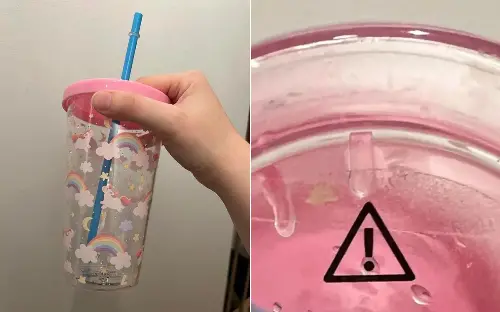
A mom was about to make her infant daughter drink from a cup gifted to her when something stopped her in her tracks, and she told Newsweek how her discovery has made her think hard about her family's use of plastics.
Veronica from Canada had thought nothing of making her four-year-old something to drink in the new pink unicorn and rainbow-themed cup.
However, a message written on the bottom of the cup and translated into French gave her pause for thought. It said: "Decorative use only, not suitable for food or beverage."
Veronica, who chose not to provide her full name, told Newsweek: "I only noticed it when I was cleaning it before using it for the first time."
The warning initially left her confused. "My first thought was, 'why even make a cup if you can't drink out of it?'" she said. "I guess my daughter could use it to play pretend? But also why would she when she can use a real cup instead?"
Ultimately she's glad she spotted the warning when she did.
"I wash things before using them, so thankfully I hadn't given it to my daughter yet. I have no clue about how dangerous it could be," she said. "But my daughter is only 4 so I'm glad I didn't let her drink in it!"
Plastic cups and containers are used by millions of people every day to carry and contain a variety of foods and drinks.
However, studies have highlighted the potential danger the chemicals present in these plastics could pose to our health.
According to the Harvard Medical School, tests have shown that some of the substances used in the making of these plastic products have, in certain conditions, the potential to "leach" or "migrate" into the food and drink they contain.
In the U.S. the Food and Drug Administration (FDA) is responsible for regulating plastic packaging and has established a set of regulations preventing manufacturers from using plastics that have the potential to release harmful levels of chemicals into the food and drink they contain.
In Canada, the Food Directorate's Bureau of Chemical Safety and Health Canada has published a list of 13 acceptable polymers for use in food packaging applications.
Vineet Dubey is an environmental litigator and cofounding partner of Custodio & Dubey LLP. He has pursued litigation against a wide variety of companies accused of endangering the health and well-being of his clients by selling products containing toxic chemicals.
When Newsweek shared pictures of the warning Veronica found with Dubey he agreed that the warning was "absolutely cause for concern." He said the cup likely fell foul of one of two issues, or potentially both.
"Generally this warning indicates that a product is not 'food grade' and may leach chemicals into food or drinks, especially if they are hot. The warning may also appear on containers that have seams which can trap food particles and make them difficult to clean, making them unhygienic," he told Newsweek.
Dubey was keen to stress that these kinds of warnings are not limited solely to plastics though. "Some glazes used in the manufacture of ceramics may contain lead, so you will often see the same warning on ceramics, because they can leach the toxic metal into food—especially harmful for children. It's there so someone doesn't accidentally use a flower vase as a drinking glass, for example," he said.
Dubey urged Veronica to "get rid of the cup." He said: "There are millions of plastic drinking cups that do not have this warning, and they are cheap and plentiful," he said. "Under such circumstances, why take a chance?"
Veronica does not know who manufactured the cup. "It was a gift, and I didn't ask, so I have no clue where it's from," she said. "It was probably in a unicorn-themed display with a mix of random items and the person who bought it for us saw the cute designs and didn't check the bottom of the cup."
She's not planning on throwing it away just yet but the warning has made her think more closely about her family's use of plastics.
"I have kept the cup. I might throw away the lid and straw and use the cup part for pencils or hair brushes in my daughter's room," she said. "I never really gave a second thought about plastic toys and other things but it did make me think about where the things my children use to eat, what they put in their mouth, etc. come from and what toxic substances they can contain."